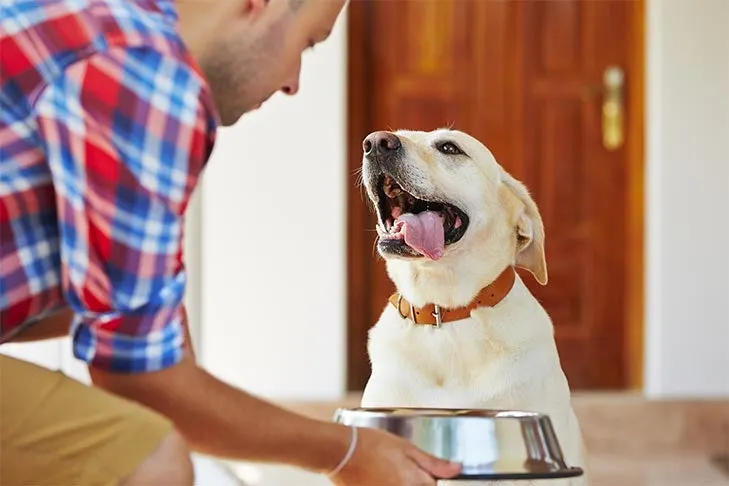Watching your beloved canine companion constantly scratch, lick their paws, or rub their face can be distressing. You’ve meticulously checked for fleas, avoided lawn fertilizers, and stuck to the same premium brand of dog food for years, yet the discomfort persists. If these symptoms sound familiar, it’s crucial to consult your veterinarian, as a food allergy could be the underlying cause. Pinpointing this condition can be challenging and often requires expert diagnosis.
Understanding Canine Food Allergies
Canine food allergies, scientifically known as cutaneous adverse food reactions (CAFR), involve a strong immune system response to specific ingredients in a dog’s diet, most commonly proteins or carbohydrates. While food allergies often manifest in young dogs, they can develop at any age. A particularly tricky aspect is that these allergies can emerge over time; a dog might consume the same food for years before exhibiting a reaction. Dr. Barbara Feinstein, a veterinarian and partner at the Cat and Dog Hospital of Columbia, notes an increase in patients with food allergies, speculating that this could be due to a heightened awareness or the evolving ingredients found in modern dog foods. Research indicates that food allergies are diagnosed in up to a quarter of dogs experiencing allergic skin reactions.
Recognizing the Symptoms of Food Allergies
The symptoms of a food allergy typically involve intense itching in areas like the feet, abdomen, face, and around the anal region. This leads dogs to scratch, chew, lick, and rub themselves excessively. Consequently, they may develop skin lesions, bacterial infections, or yeast infections. Ear infections are also common, affecting approximately 50% of dogs with food allergies, and sometimes serve as the sole symptom. Around 30% of affected dogs, especially puppies, may also experience gastrointestinal issues such as diarrhea or vomiting. In rare instances, more severe reactions like bronchitis or anaphylaxis can occur. Dr. Feinstein emphasizes that dogs with food allergies often suffer from other environmental allergies, such as those to mold, pollen, dust mites, or insect bites. Addressing your dog’s discomfort promptly with a veterinarian is essential to determine the cause, alleviate symptoms, and prevent secondary infections.
Diagnosing Dog Food Allergies: A Complex Process
Diagnosing food allergies is not straightforward, as many other conditions present similar symptoms. When evaluating a patient, veterinarians like Dr. Feinstein first rule out other potential causes. This involves checking for external parasites like fleas or ticks, and for ringworm, which may require skin scrapings or cultures. Blood tests can help exclude conditions such as Cushing’s Disease or hypothyroidism. A thorough discussion with the owner about any environmental changes helps rule out contact dermatitis. Veterinarians will also inquire whether the irritations are seasonal and if other family members are experiencing similar lesions, as ringworm and mites can affect humans.
Food Sensitivity vs. Food Allergy
Dr. Feinstein will also meticulously examine the dog’s diet, including all treats and table scraps, to consider a food sensitivity. Unlike an immunological food allergy, a food sensitivity is a chronic condition, such as a dog reacting with diarrhea and vomiting to high-fat foods. Some veterinarians do not differentiate between food sensitivities and allergies, as both ultimately require a dietary change to relieve symptoms. While it can seem overwhelming, owners should always read the ingredient list before purchasing [dehydrated dog food](https://dogcarestory.com/dehydrated-dog-food/) or any dog food. It is advisable to review at least the first four ingredients and consult your veterinarian for recommendations before making any dietary adjustments.
Preparing for Your Vet Visit
To assist your veterinarian in this diagnostic process, it’s vital to have one consistent point of contact who can provide detailed information. Be prepared to answer questions such as:
- What
[Dog Food For Dogs With Allergies](https://dogcarestory.com/)are you currently feeding your dog, and for how long? - What treats, medications, and human table scraps does your dog consume?
- How and where is the dog food stored?
- Is your dog currently on any
[bravecto spot on](https://dogcarestory.com/bravecto-spot-on/)or other flea and tick preventatives? - If you have other pets, what do they eat?
- Have there been any recent changes to your dog’s environment?
- When did the itching start, and does it worsen during specific seasons?
- Is anyone else in the household experiencing itching?
 Cavalier King Charles Spaniel standing next to its food bowl at home.
Cavalier King Charles Spaniel standing next to its food bowl at home.
Common Dog Food Allergens and Susceptible Breeds
Historically, chicken was considered the most likely protein to cause food allergies in dogs. However, current research indicates that common allergens now include beef, dairy, wheat, and lamb. Studies also report canine allergic reactions to soybean, eggs, corn, and even walnuts.
Certain dog breeds appear to be genetically predisposed to developing food allergies. These include the Boxer, Labrador Retriever, Pug, Rhodesian Ridgeback, and West Highland White Terrier. German Shepherd Dogs and Golden Retrievers also show a higher incidence of food allergies.
Managing Dog Food Allergies: The Elimination Diet
Unfortunately, there is no definitive cure for food allergies; the primary approach to managing them is to identify the specific allergen and completely remove it from your dog’s diet. The most reliable method for pinpointing the cause of a food allergy is through an elimination diet. While this process is underway, your veterinarian can help alleviate your dog’s symptoms by prescribing anti-inflammatory medications like Cytopoint, Apoquel, or prednisone.
Types of Elimination Diets
There are two primary types of elimination diets used to address canine food allergies:
- Novel Protein Diets: These diets feature a single, new protein source and a single carbohydrate that your dog has never consumed before, with minimal additives. They are specifically formulated to avoid ingredients present in the dog’s previous diet. Crucially, novel protein diets should not include ingredients that could cause cross-reactivity with proteins from the dog’s prior food, such as lamb, beef, and milk or chicken, whitefish, and salmon.
- Hydrolyzed Protein Diets: In these diets, the protein is broken down into very small fragments, making them easier to digest and less likely to trigger an immune response. However, some dogs can still experience allergic reactions even to these highly processed proteins.
Dr. Feinstein often recommends prescription novel protein diets provided by veterinarians, noting their improved palatability compared to previous formulations. Some veterinarians may suggest a single-protein diet to simplify understanding what your dog is eating. It’s important to know not only the brand but also the specific protein content of your dog’s food. Be aware that commercial diets, even specialized ones, can sometimes be contaminated with other proteins during manufacturing or contain unlabeled ingredients. [Gastrointestinal dog food](https://dogcarestory.com/gastrointestinal-dog-food/) might also be recommended for dogs with sensitive stomachs, but it’s important to differentiate between sensitivity and allergy.
Home-cooked diets, prepared with ingredients specified by your veterinarian, can be effective if they are properly balanced and meet the Association of American Feed Control Officials (AAFCO) standards. However, achieving a complete nutritional balance independently can be challenging, particularly when feeding [mushroom for dogs](https://dogcarestory.com/mushroom-for-dogs/) or other special ingredients, especially for young, large-breed dogs.
 Man reading a food label on a bag of dog food at the store.
Man reading a food label on a bag of dog food at the store.
Strict Adherence to the Elimination Diet
For an elimination diet trial to effectively identify food allergies in over 90% of dogs, it must last at least 8 weeks. Dr. Feinstein often suggests a 12-week trial to span two seasons, helping to differentiate food allergies from potential seasonal environmental allergies. Following the initial trial, some veterinarians may introduce a challenge phase, adding ingredients back into the diet one at a time to identify the specific foods causing the allergic reaction.
These diets demand strict management and the full cooperation of all family members. Dog owners must eliminate all food items except the prescribed food. This includes all treats, [dentastix for dogs](https://dogcarestory.com/dentastix-for-dogs/) and other dental chews, table scraps, rawhide chews, oral medications and preventatives, pill pockets, flavored toothpaste, and even flavored toys. If there are other animals in the household, they must be fed separately, and shared water dishes should be avoided to prevent accidental consumption of non-prescription foods.
Long-Term Management
If the new diet proves successful in alleviating your dog’s symptoms, Dr. Feinstein advises continuing with that specific food. “Dogs won’t grow out of an allergy, so in my mind there’s no point in reintroducing food we think gave them an allergic reaction.” While a new, specialized food might be more expensive, the costs associated with repeated vet visits and medications for untreated allergies can quickly add up, and more importantly, your dog continues to suffer. Once you discover a food that keeps your dog healthy and meets their nutritional needs, consistency is key.
 Happy Yellow Labrador Retriever with its owner and food bowl
Happy Yellow Labrador Retriever with its owner and food bowl
In conclusion, understanding and managing [dog food for dogs with allergies](https://dogcarestory.com/) requires patience, vigilance, and close collaboration with your veterinarian. By carefully observing symptoms, adhering to diagnostic protocols like the elimination diet, and committing to a suitable long-term dietary plan, you can significantly improve your allergic dog’s quality of life and ensure they remain happy and healthy.
